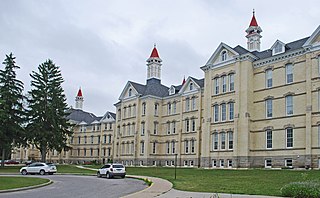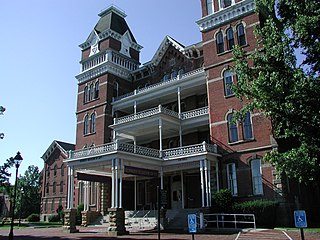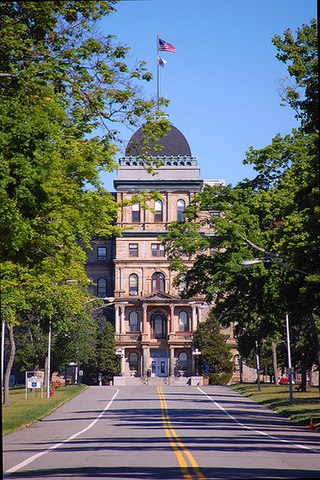
Psychiatric hospitals, also known as mental health hospitals or behavioral health hospitals, are hospitals or wards specializing in the treatment of severe mental disorders, such as schizophrenia, bipolar disorder, eating disorders, dissociative identity disorder, major depressive disorder and many others. Psychiatric hospitals vary widely in their size and grading. Some hospitals may specialize only in short-term or outpatient therapy for low-risk patients. Others may specialize in the temporary or permanent confinement of patients who need routine assistance, treatment, or a specialized and controlled environment due to a psychiatric disorder. Patients often choose voluntary commitment, but those who psychiatrists believe pose significant danger to themselves or others may be subject to involuntary commitment and involuntary treatment. Psychiatric hospitals are sometimes referred to as psychiatric wards/units, psych, or wards/units when they are located as a unit within a hospital.
Historically, mental disorders have had three major explanations, namely, the supernatural, biological and psychological models. For much of recorded history, deviant behavior has been considered supernatural and a reflection of the battle between good and evil. When confronted with unexplainable, irrational behavior and by suffering and upheaval, people have perceived evil. In fact, in the Persian Empire from 550 to 330 B.C., all physical and mental disorders were considered the work of the devil. Physical causes of mental disorders have been sought in history. Hippocrates was important in this tradition as he identified syphilis as a disease and was, therefore, an early proponent of the idea that psychological disorders are biologically caused. This was a precursor to modern psycho-social treatment approaches to the causation of psychopathology, with the focus on psychological, social and cultural factors. Well known philosophers like Plato, Aristotle, etc., wrote about the importance of fantasies, dreams, and thus anticipated, to some extent, the fields of psychoanalytic thought and cognitive science that were later developed. They were also some of the first to advocate for humane and responsible care for individuals with psychological disturbances.

Austin State Hospital (ASH), formerly known until 1925 as the Texas State Lunatic Asylum, is a 299-bed psychiatric hospital located in Austin, Texas. It is the oldest psychiatric facility in the state of Texas, and the oldest continuously operating west of the Mississippi River. It is operated by the Texas Health and Human Services Commission.

Henry Andrews Cotton was an American psychiatrist and the medical director of the New Jersey State Hospital at Trenton, in Trenton, New Jersey. During his tenure from 1907 to 1930, Cotton and his staff employed experimental surgery and bacteriology techniques on patients, which included the routine removal of some or all of patients' teeth as well as tonsils, spleens, colons, ovaries, and other organs. These pseudoscientific practices persisted even after statistical reviews disproved Cotton's claims of high cure rates and revealed high mortality rates as a result of these procedures.

Adolf Meyer was a Swiss-born psychiatrist who rose to prominence as the first psychiatrist-in-chief of the Johns Hopkins Hospital (1910-1941). He was president of the American Psychiatric Association in 1927–28 and was one of the most influential figures in psychiatry in the first half of the twentieth century. His focus on collecting detailed case histories on patients was one of the most prominent of his contributions. He oversaw the building and development of the Henry Phipps Psychiatric Clinic at Johns Hopkins Hospital, opened in April 1913, making sure it was suitable for scientific research, training and treatment. Meyer's work at the Phipps Clinic is possibly the most significant aspect of his career.

The Utica Psychiatric Center, also known as Utica State Hospital, opened in Utica on January 16, 1843. It was New York's first state-run facility designed to care for the mentally ill, and one of the first such institutions in the United States. It was originally called the New York State Lunatic Asylum at Utica. The Greek Revival structure was designed by Captain William Clarke and its construction was funded by the state and by contributions from Utica residents.

The Athens Lunatic Asylum, now a mixed-use development known as The Ridges, was a Kirkbride Plan mental hospital operated in Athens, Ohio, from 1874 until 1993. During its operation, the hospital provided services to a variety of patients including Civil War veterans, children, and those declared mentally unwell. After a period of disuse the property was redeveloped by the state of Ohio. Today, The Ridges are a part of Ohio University and house the Kennedy Museum of Art as well as an auditorium and many offices, classrooms, and storage facilities.

Greystone Park Psychiatric Hospital referred to both the former psychiatric hospital and the historic building that it occupied in Morris Plains, New Jersey. Built in 1876, the facility was built to alleviate overcrowding at the state's only other "lunatic asylum" located in Trenton, New Jersey.

Deinstitutionalisation is the process of replacing long-stay psychiatric hospitals with less isolated community mental health services for those diagnosed with a mental disorder or developmental disability. In the late 20th century, it led to the closure of many psychiatric hospitals, as patients were increasingly cared for at home, in halfway houses and clinics, in regular hospitals, or not at all.
Central State Hospital is a 192-bed adult psychiatric hospital located in the Lakeland neighborhood of Louisville, Kentucky. In 1869, 200 acres were purchased by the Kentucky State Legislature from the descendants of renown frontiersman Issac Hite to establish a "State House of Reform for Juvenile Delinquents." This was located on the outskirts of what would become Anchorage, Kentucky. In 1873, due to overcrowding at both of Kentucky's mental hospitals, the House of Reform was converted into the Fourth Kentucky Lunatic Asylum, with Dr. C.C. Forbes as its first Superintendent. The following year an act of the legislature renamed it the Central Kentucky Lunatic Asylum. In late 1887, it received its own post office, called simply "Asylum". The following year its name was changed to "Lakeland", and the institution was commonly referred to as "Lakeland Hospital" or "Lakeland Asylum". By 1900, its official name had been changed to the Central Kentucky Asylum for the Insane. By 1912 it was known as Central State Hospital. Comparable institutions are Eastern State Hospital at Lexington in Fayette County and Western State Hospital at Hopkinsville, Christian County, Kentucky. All three were administered by the Board of Charitable Organizations.
The Association of Medical Superintendents of American Institutions for the Insane, also known as The Superintendents' Association, was organized in Philadelphia in October, 1844 at a meeting of 13 superintendents, making it the first professional medical specialty organization in the U.S.

The Kalamazoo Psychiatric Hospital (KRPH) is the largest mental health institution in Michigan. It was built under the Kirkbride Plan.

Ten Days in a Mad-House is a book by American journalist Nellie Bly. It was initially published as a series of articles for the New York World. Bly later compiled the articles into a book, being published by Ian L. Munro in New York City in 1887.

Norristown State Hospital, originally known as the State Lunatic Hospital at Norristown, is an active state-funded psychiatric hospital located outside the city of Philadelphia in suburban Norristown, Pennsylvania. It was originally designed between 1878 and 1880, by the local firm of Wilson Brothers & Company; of which, the original structure was set in a red brick Victorian High Gothic motif. It remains active for its originally clinical intention, and currently serving Bucks County, Chester County, Delaware County, Montgomery County and Philadelphia County, providing clinical services in General Psychiatry and Forensic Psychiatry. Additionally, there are various agencies that sublet state hospital buildings for a variety of psychiatric, residential and social services. These agencies currently make up the majority of services that are offered on the grounds of the hospital.

Madhouse: A Tragic Tale of Megalomania and Modern Medicine is a 2005 book by the psychiatric sociologist Andrew Scull which discusses the work of the controversial psychiatrist Henry Cotton at Trenton State Hospital in New Jersey in the 1920s.

The lunatic asylum or insane asylum was an early precursor of the modern psychiatric hospital.

St. Brendan's Hospital was a psychiatric facility located in the north Dublin suburb of Grangegorman. It formed part of the mental health services of Dublin North East with its catchment area being North West Dublin. It is now the site of a modern mental health facility known as the "Phoenix Care Centre". Since the official opening of the Richmond Lunatic Asylum in 1815 the Grangegorman site has continuously provided institutional facilities for the reception of the mentally ill until the present day. As such the Phoenix Care Centre represents the continuation of the oldest public psychiatric facility in Ireland.

William Hunter CB FRSE was a British surgeon known primarily for his theories on oral sepsis, one of the inspirations for the Henry Cotton theory of focal sepsis which led to the increased number of tooth extractions and tonsillectomies in the 1910s and 20s. By the 1930s, this view had fallen out of favor, but not until after thousands of surgeries had been performed.

Prestwich Hospital was a mental health facility in Prestwich, Greater Manchester, England.


















